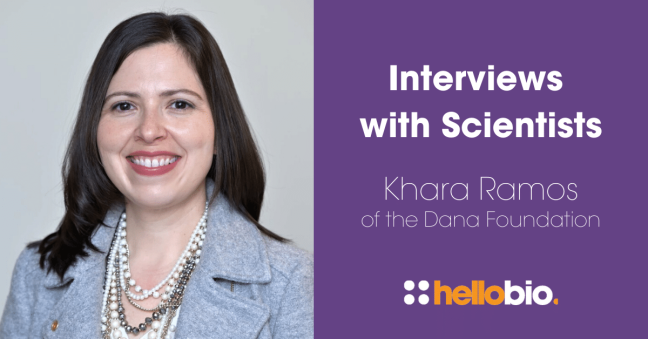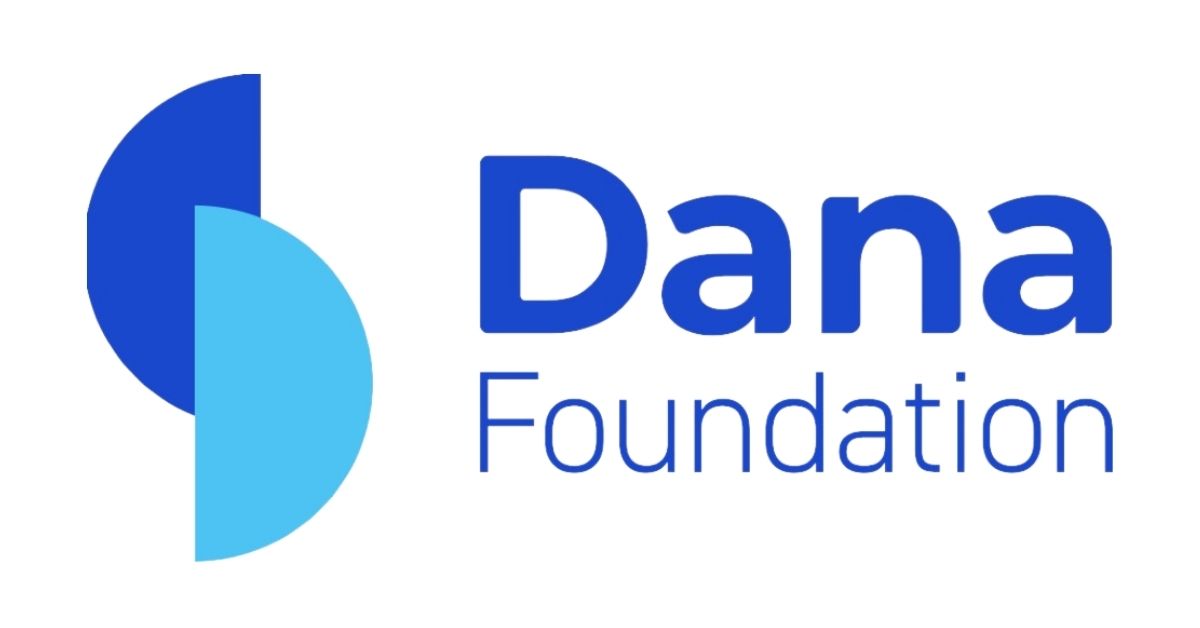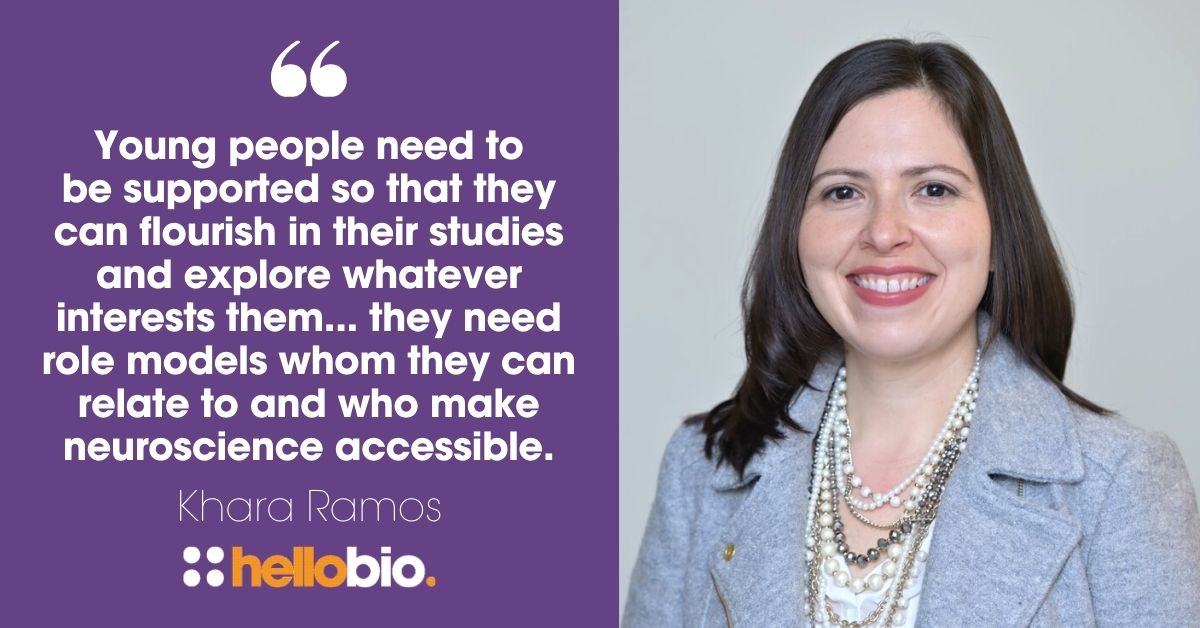Interviews with Scientists: Khara Ramos
It’s Brain Awareness Week (14-20 March) and we’ve been lucky enough to speak with Khara Ramos of the Dana Foundation. Khara is Vice President of Neuroscience within Society at the foundation who are responsible for coordinating the global Brain Awareness Week campaign each year.
Before joining the Dana Foundation, Khara was the director of the neuroethics program and led the neuroscience content and strategy branch in the communications office at the National Institutes of Neurological Disorders and Stroke (NINDS) at the National Institutes of Health (NIH). She originally moved from academia to federal service through the AAAS Science and Technology Policy Fellowship Program, following a post-doctoral fellowship at the University of Colorado, Boulder, where she studied the role of non-neuronal cells of the central nervous system in chronic pain and opioid-induced central sensitization. She holds a Ph.D. in neurosciences from the University of California, San Diego, and a bachelor’s degree with honors in Symbolic Systems from Stanford University.
We spoke to Khara about her role at the Dana Foundation, her thoughts on current life science issues, and the aims of the Brain Awareness Week campaign.
Thanks for speaking with us, Khara! Firstly, please can you tell us a bit about your role at the Dana Foundation?
I serve as the Foundation’s inaugural Vice President of Neuroscience within Society, with responsibility for the Foundation’s strategy and programs in that area. ‘Inaugural’ tells you that this is a new focus for the Foundation! Building upon our strong legacy of research and public outreach in neuroscience, the Dana Foundation’s new focus is “neuroscience within society”, or how neuroscience both informs and reflects society. There is no doubt that scientific discovery and technology development create new knowledge and can generate solutions to societal issues and increase quality of life. Neuroscience holds immense promise, both to illuminate the inner workings of the mind and to bend the curve on diseases of the brain and nervous system. But, with great power comes great responsibility, and we are building programs to help ensure that neuroscience progresses in alignment with societal values and in support of human flourishing.
You hold a PhD in neurosciences from the University of California, San Diego. What was the focus of your PhD research?
I was interested in doing research that might have near-term impact for the many nervous system-based diseases that cause immense human suffering around the world. My dissertation research focused on understanding what goes wrong in the nervous system – specifically the spinal cord – for people who develop pain due to diabetes. This type of pain can be incredibly debilitating and is not easy to treat.
Did you always want to work in science when you were younger, and if so why?
I didn’t really think of it that way – but I was always curious about everything. Around the time of middle school, I got the idea that I wanted to be a pediatric cardiologist one day. I suppose it combined my budding interest in biology with an innate wish to help other people. I did not end up going to medical school but happily my work still combines those elements of curiosity and service.
What excites you most about neuroscience research?
It’s hard to pick just one thing so let me give two examples. First, brain-based diseases and disorders are the leading cause of disability and the second leading cause of death worldwide. These diseases and disorders are numerous and include, for example, stroke, Alzheimer’s and other dementias, substance use disorders, and mood disorders. The promise of being able to treat or even prevent these conditions is incredibly exciting, because of the human suffering and economic toll that these conditions cause. Second, neuroscience will increasingly reveal to us the nature of our own human minds, and also what’s going on in the minds of other animals. I am fascinated by the idea of different nervous system blueprints in different types of animals, and different ways of using those nervous systems to live in this world, each incredibly specialized for the particular niche that a given creature occupies. What would it be like to be an octopus, with embodied cognition in your tentacles? Or to be a dolphin or bat and live in a world that’s painted by sound?
What do you think are the biggest challenges facing neuroscientists today?
One challenge that has persisted since I was a trainee is for early career neuroscientists to understand the full landscape of career opportunities available to them outside of academia. There simply aren’t enough academic positions to support all the neuroscientists we are training, and there are so many ways that neuroscientists can apply their skills and knowledge to do good things in the world – beyond academia.
Brain Awareness Week is a global campaign coordinated by the Dana Foundation. Can you tell us a little about it?
Brain Awareness Week (BAW) is the global campaign to foster public enthusiasm and support for brain science. It began back in 1996! Every March, partners host imaginative activities in their communities that share the wonders of the brain and the impact brain science has on our everyday lives. Popular events include lectures and panel discussions; lab tours and open houses at research facilities; brain fairs with hands-on activities, demonstrations, and experiments; programs at K-12 schools; art and literature competitions; film screenings followed by audience discussions; museum exhibitions about the brain; concerts and theatrical performances; and social media campaigns.
Why is Brain Awareness Week so important and what are the main aims of the campaign?
BAW is a wonderful opportunity for neuroscientists to step out of their labs and connect with members of their local communities. Scientists not only inform and excite their communities about the research being done in their backyards, but also learn from the public about the issues and topics in neuroscience that are of interest and concern to them. It’s also an opportunity for relaxed and informal exchange between scientists and the public; scientists can share their stories and career paths, and build mutual trust and understanding with the public.
The aims of the campaign are:
- To spread the word about the importance of brain science and its critical role in helping people lead healthier, more productive lives.
- To ensure a future for neuroscientific discovery by inspiring the next generation of scientists.
- To provide the public with the knowledge they need to make informed decisions about their health.
What else could be done to encourage more young people to explore neuroscience?
Young people are naturally curious about the world and neuroscience has a natural allure – after all, we all have brains and rely on them constantly, yet we still understand relatively little about how brains work given how incredibly complex they are. It’s very natural for young people to want to explore the unknown. I think young people need to be supported so that they can flourish in their studies and explore whatever interests them – neuroscience or otherwise. And they need role models whom they can relate to and who make neuroscience accessible.
What key piece of advice would you give to a young neuroscientist just starting out in their career?
Neuroscience is inherently an interdisciplinary field, and it is often the case that the biggest leaps in science happen when fields converge. So, as you progress in your career, look for information and people in fields that are one degree of separation away from where you are. This will enhance your thinking, your ability to solve problems, even your ability to conceptualize what questions to ask.
Women remain underrepresented in all fields of STEM. What more do you think could be done to improve the gender balance in science?
Inequities in science reflect inequities in our societies. Those inequities are systemic and need systemic change to be rectified. I believe that to achieve true diversity, equity, and inclusion in science will require our societies to also find the path to attain these ideals. And though they are ideals they are also absolutely essential for a healthy and flourishing world, in addition to simply being the right thing to do. We face many critical problems around the world and to solve them, we need to harness the best thinking of all kinds of people from all over the world.
Who has been your greatest role model, and why?
I’ve been lucky to have many great mentors over the years. Most recently, I was fortunate to work closely with Dr. Christine Grady, the Chief of Bioethics at the National Institutes of Health (NIH) in my former role as Director of the Neuroethics Program at NIH. Christine is incredibly smart, compassionate, and humble. To me she embodies a style of leadership that is unique and valuable.
What's the most important lesson you have learned in your career so far?
A career is not a linear thing. I have seen so many instances of people feeling frustrated because they are expecting a simple linear progression in their career. I encourage people instead to think of a career as a process, one in which you are exploring a three-dimensional space of possibilities. With this mindset, you can be more open to opportunities that might seem adjacent to what you are currently doing – and that could reveal incredible matches for your interests and abilities.
What’s your favourite inspirational science quote?
Carl Sagan wrote in Cosmos: “We make our world significant by the courage of our questions and the depth of our answers.” To me this captures both being willing to ask difficult questions and to deal with the reality of things as they are, not as we might wish them to be. Both of these things definitely require courage.
How can our readers find out more about Brain Awareness Week?
I encourage readers to visit https://brainawareness.org, the official campaign website. You can search our global calendar for events to attend in your area https://brainawareness.org/calendar. Events in 34 countries and 27 U.S. states are currently posted on the calendar! Also, follow the Dana Foundation and Brain Awareness Week on social media for updates and information on how you can get involved.
_________________________________________________
Thank you so much for a fascinating interview, Khara! We wish you all the best with the ongoing work of the foundation and the Brain Awareness Week campaign.
Connect with Khara and find out more about the Dana Foundation:
LinkedIn: Khara Ramos, Ph.D.
Twitter: @KharaRamos
Twitter: @dana_fdn
Instagram: @danafoundation
Website: https://www.dana.org/
_________________________________________________
If you enjoyed this article, why not check out the other resources available on our blog. We are passionate about supporting life scientists including early career life scientists and PhD students - with really low-priced reagents and biochemicals, early career scientist grants, and resources to help with both personal and professional development. We know how tough it is - so we hope you find these helpful!
More General Support for Life Scientists
For advice on writing papers, dissertations, presenting at conferences, wellbeing, PhD support, networking and lots more, we have a huge range of articles to help - just click below:
Save up to 50% on our high purity reagents...
When you get to the stage of planning your experiments, don't forget that we offer a range of low-cost, high-purity agonists, antagonists, inhibitors, activators, antibodies and fluorescent tools (yes - they really are around half the price of other suppliers!) You can use our Quick Multi-Search Tool to search for lots of products in one go, and the range includes:
- Enzyme inhibitors and activators
- Chemogenetic ligands
- Ion channel modulators
- GPCR & ionotropic receptor ligands
- Cell biology reagents & biochemicals
Technical resources
Try our Molarity Calculator: a quick and easy way to calculate the mass, volume or concentration required for making a solution.
Try our Dilution Calculator: an easy way to work out how to dilute stock solutions of known concentrations
And finally, don't forget to check back in with our blog regularly for our latest articles. If there’s something you’d love to contribute to the community, whether that’s an interview or article, drop us a line at hello@hellobio.com
---





















